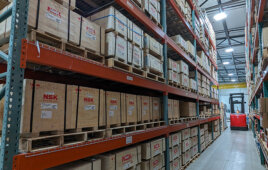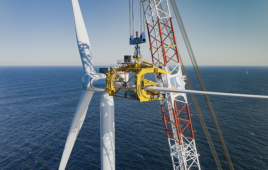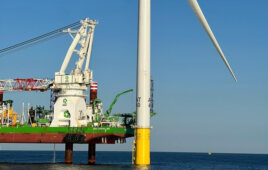By Patrik Lundström Törnquist & Anders Söderman
BUMAX
Galling is a form of wear that is caused by metal surfaces in gliding contact with one other, such as the many bolts and fasteners holding rotor blades together in wind turbines. With potentially disastrous and costly effects resulting from galled fasteners seizing or even subject to a fatigue breakage, the wind energy industry players are advised to counter this threat.

Galling, a form of mechanical wear caused by excessive friction, poses a serious threat to the quality and safety of costly and critical assets, including wind turbines.
Standard stainless steel bolts and fasteners have a tendency to gall under certain conditions because of their specific properties. Thread galling can occur with standard fasteners when pressure and friction cause the bolt threads to seize to the threads of a nut or a tapped hole.
Severe galling, known as “cold welding,” can also cause the two surfaces to fuse together. This makes the joint impossible to remove without cutting the bolt or splitting the nut. The consequences and implications of galling should never be underestimated.
A galled fastener may be unable to achieve the necessary pre-load and, particularly, in case of dynamic loading. This jeopardizes the entire purpose for using fasteners (i.e. to securely fasten two surfaces together). What’s more is this risk may involve hundreds of stainless steel fasteners, such as with rotor blades.
In the worst-case scenario, the fatigue breakage of critical fasteners can have serious safety implications that might result in accident or injury. Galled fasteners are also much more susceptible to corrosion, which can ultimately result in breakages and high maintenance costs.
Catastrophic failures
Galling is an issue in many segments and applications, wherever stainless steel fasteners are used. For example, in the wind energy industry, there is a risk of catastrophic failures if the thread galls before sufficient torque has been obtained. This covers most if not all machines and devices with moving parts.
Wind-turbine manufacturers typically use a premium fastener like the BUMAX 88 for rotor blade bolts because it has a high molybdenum content that makes the joints extra durable, reliable, and corrosion-resistant. In extreme cases, galling can lead to the fastener breaking and failure of the application. The risk is highest for applications that are exposed to dynamic loads.
However, galling can be overcome even in the most challenging of applications – particularly by selecting premium quality stainless steel fasteners.
Prevention
It is important to consider how galling can be avoided from the outset when engineering a fastener application to decrease the chance of repairs and maintenance costs. To minimize galling and its negative consequences, it is essential to be aware of the concept of galling and ensure that only premium stainless steel fasteners are used in critical applications.

Component choice is critical in wind turbines — even down to the nuts and bolts — because certain types of stainless steel are more prone to galling due to their atomic structure.
Premium fasteners may look similar to standard stainless steel fasteners, but their superior material properties can make a significant O&M difference. Premium stainless steel fasteners also typically offer other properties that are essential in many critical fastener applications – including corrosion-resistance and high tensile strength.
Using premium fasteners that are at a lower risk of galling offer the following benefits:
- Less maintenance, stoppages, and other production disturbances. Most machines used in production are designed to clock up thousands of hours of “work” with very little downtime. Any downtime can be very costly in terms of repairs and lost operational revenues. A well-known German construction company of offshore wind turbines used to weld the tower construction, but experienced costly and complicated maintenance work when service ships collides into the construction at heavy sea. Changing from welded joints to BUMAX stud fasteners made it much easier to replace damaged parts and has thereby lowered the maintenance cost.
- Increased safety and security. If a fastener malfunctions or breaks, the result can be dangerous and even disastrous, depending on the application.
- Increased cost-effectiveness. Using the best fasteners from the very start can save a lot of money down the line.
The extra cost for premium fasteners pales in comparison to repair and replacement costs. Besides choosing the correct fasteners, there are other preventative measures to take:
1. Select the correct material. Selecting the correct material for your specific application is extremely important as certain types of stainless steel are more prone to galling due to their atomic structure. In particular, strain-hardened stainless steels that have been cold formed provide excellent galling resistance due to their improved strength and reduced ductility.
2. Choose fasteners with a perfect fit. As galling is common between metal surfaces that are in sliding contact with each other, premium fasteners that are designed to perfectly fit together can significantly reduce the risk of galling as they minimize movement and friction. Here, high-quality threads with less surface deviations that can rub together and lead to galling issues are particularly essential.
3. Lubrication matters. Lubrication is an important way to reduce galling by allowing the two materials to slide past each other without causing friction. Some leading premium fastener manufacturers use custom-made wax to ensure an optimal friction coefficient. Anti-seizing and anti-galling lubricants can also help reduce galling.
4. Discard damaged fasteners.
A bolt with dented or damaged threads has a significantly increased chance of galling. Check all fasteners for damage that may have occurred during shipping. Dirty bolts with debris in the threads can also greatly increase the risk of galling – so make sure you only use clean bolts.
5. Careful installation is key. As most stainless steel is more sensitive to high temperatures, tightening bolts more slowly can reduce friction and heat that can cause galling. This may involve avoiding the use of power tools that can cause excessive friction and heat. Calculations should be made for particular applications to determine the kind of tools that can be used.

Patrik Lundström Törnquist
You must ask yourself: How valuable are your wind energy assets? Is it worth gambling on cheaper, galling-prone fasteners and bolts rather than premium stainless steel fasteners that are specifically developed to minimize galling?
Wind energy industry executives must be aware of the potentially disastrous implications of fasteners failing due to galling, and do their utmost to prevent this from happening. This cannot be left to chance.
The authors…
Patrik Lundström Törnquist is Managing Director of BUMAX. He has more than 20 years of experience from C-level positions in the global mining, steel, manufacturing and

Anders Söderman
engineering industries. He has an M.Sc. from the Chalmers University of Technology and an M.B.A. from the Hult International Business School.
Anders Söderman is Technical Director of BUMAX, a leading Swedish specialist manufacturer of premium stainless steel fasteners. Mr. Söderman has worked in the stainless steel industry since 1995 and has an M.Sc. in Materials Science from the Dalarna University in central Sweden.
Filed Under: Bolts and bolting, Components, Featured, O&M





I am working with a company in Holland who have developed an amazing dry Lubrication. Damaged Bolts are repaired by this Lubrication and the friction coefficient is reduced dramatically. I am trying to help the company enter in to the Wind industry where I have ran many Bolting and re bolting campaigns on Wind farms. I know the many problems faced during bolting and this product has all the answers.
This company already supply their Lubrication Worldwide in the Stainless Steel industry and food industry.
The Lubrication is totally natural and echo Friendly, so much so that you can actually eat it!!
Can someone please advise me of people to contact to demonstrate this Lubrication to the major players in the Wind industry. I believe it is definitely the Future in Bolt Lubricant offshore.
Just a detail gap between metal surfaces also hould be evaluated.